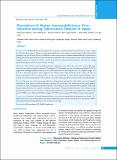Please use this identifier to cite or link to this item:
https://hdl.handle.net/20.500.14356/1426Full metadata record
| DC Field | Value | Language |
|---|---|---|
| dc.contributor.author | Adhikari, Nilaramba | - |
| dc.contributor.author | Bhattarai, Ratna | - |
| dc.contributor.author | Basnet, Rajendra | - |
| dc.contributor.author | Tinkari, Bhim Singh | - |
| dc.contributor.author | Gyawali, Badri Nath | - |
| dc.contributor.author | Joshi, Lok Raj | - |
| dc.date.accessioned | 2023-05-10T10:33:24Z | - |
| dc.date.available | 2023-05-10T10:33:24Z | - |
| dc.date.issued | 2019 | - |
| dc.identifier.citation | AdhikariN., BhattaraiR., BasnetR., TinkariB. S., GyawaliB. N., & JoshiL. R. (2019). Prevalence of Human Immunodeficiency Virus Infection among Tuberculosis Patients in Nepal. Journal of Nepal Health Research Council, 17(01), 15-20. https://doi.org/10.33314/jnhrc.v17i01.1768 | en_US |
| dc.identifier.issn | Print ISSN: 1727-5482; Online ISSN: 1999-6217 | - |
| dc.identifier.uri | http://103.69.126.140:8080/handle/20.500.14356/1426 | - |
| dc.description | Original Article | en_US |
| dc.description.abstract | Abstract Background: National Tuberculosis Program has envisioned to provide human immunodeficiency virus testing for all tuberculosis patients. However, human immunodeficiency virus testing coverage among notified tuberculosis patients is very low in Nepal. Hence, it is difficult to reflect the prevalence of human immunodeficiency virus infection among Tuberculosis patients based on the information available from the routine system. Hence National Tuberculosis Program carried out sentinel surveillance to assess the prevalence of human immunodeficiency virus infection among tuberculosis patients and its associated factors in Nepal. Methods: This study is cross-sectional study type conducted at six sentinel sites across the country. This study lasted for six months starting from March 2017 to August 2017. The sample size was calculated using Epiinfo STATCAL application assuming confidence interval at 95%, 85% power and 5% non-response rate. The required sample size was 1672 tuberculosis patients. Ethical approval was obtained from Nepal Health Research Council. All types of tuberculosis patients who were equal or above 15 years were included in the study. Human immunodeficiency viruse testing was performed among tuberculosis patients as per the testing algorithm recommended by national guideline. Results: The study was carried out among 1664 tuberculosis patients registered for tuberculosis treatment during the study period. More than two thirds of tuberculosis patients (67%) were male. The median age of tuberculosis patients was found 32 years. During human immunodeficiency virus testing, 41 out of 1664 tuberculosis patients were found human immunodeficiency virus positive resulting human immunodeficiency virus infection seroprevalence among tuberculosis patients to 2.5%. Prevalence of human immunodeficiency virus infection was significantly associated with age (P=0.002), caste/ethnicity (P=0.025), religion (P=0.015) and occupation (P=0.014) of tuberculosis patients. Conclusions: Prevalence of human immunodeficiency virus infection among tuberculosis patients was found 2.5%. Information and access to tuberculosis/human immunodeficiency virus services needs to be increased toaddress tuberculosis-human immunodeficiency virus co-infection in Nepal. Keywords: HIV; prevalence; TB; TB-HIV coinfection. | en_US |
| dc.language.iso | en | en_US |
| dc.publisher | Nepal Health Research Council | en_US |
| dc.relation.ispartofseries | Jan-March, 2019;1768 | - |
| dc.subject | HIV | en_US |
| dc.subject | Prevalence | en_US |
| dc.subject | TB | en_US |
| dc.subject | TB-HIV coinfection | en_US |
| dc.title | Prevalence of Human Immunodeficiency Virus Infection among Tuberculosis Patients in Nepal | en_US |
| dc.type | Journal Article | en_US |
| local.journal.category | Original Article | - |
| Appears in Collections: | Vol. 17 No. 1 Issue 42 Jan - Mar 2019 | |
Files in This Item:
| File | Description | Size | Format | |
|---|---|---|---|---|
| 1768-Article Text-10575-1-10-20190801.pdf | Fulltext Download | 254.63 kB | Adobe PDF |  View/Open |
Items in DSpace are protected by copyright, with all rights reserved, unless otherwise indicated.
